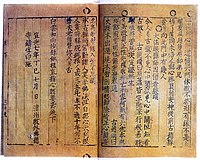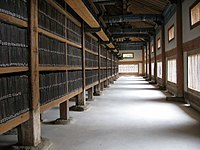
A | B | C | D | E | F | G | H | CH | I | J | K | L | M | N | O | P | Q | R | S | T | U | V | W | X | Y | Z | 0 | 1 | 2 | 3 | 4 | 5 | 6 | 7 | 8 | 9
Republic of Korea | |
|---|---|
| Anthem: 애국가 Aegukga "The Patriotic Song" | |
National seal: | |
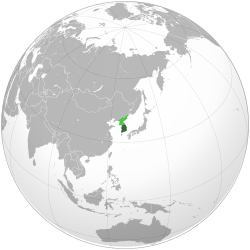 Territory controlled
| |
| Capital and largest city | Seoul 37°33′N 126°58′E / 37.550°N 126.967°E |
| Official languages | Korean (Pyojuneo) Korean Sign Language[1] |
| Official script | Hangul |
| Ethnic groups (2019)[2] | |
| Religion |
|
| Demonym(s) | |
| Government | Unitary presidential republic |
| Yoon Suk Yeol | |
| Han Duck-soo | |
| Kim Jin-pyo | |
| Cho Hee-dae | |
| Lee Jongseok | |
| Legislature | National Assembly |
| Establishment history | |
• Gojoseon | 2333 BCE (mythological) |
| 57 BCE | |
| 668 | |
• Goryeo dynasty | 918 |
• Joseon dynasty | 17 July 1392 |
| 12 October 1897 | |
| 22 August 1910 | |
| 1 March 1919 | |
| 11 April 1919 | |
| 2 September 1945 | |
• US administration of Korea south of the 38th parallel | 8 September 1945 |
| 15 August 1948 | |
| 25 February 1988 | |
| Area | |
• Excl. North Korea | 100,413[5][6] km2 (38,770 sq mi) (107th) |
• Water (%) | 0.3 |
• Incl. North Korea | 223,172 km2 (86,167 sq mi) |
| Population | |
• 2023 estimate | |
• Density | 507/km2 (1,313.1/sq mi) (15th) |
| GDP (PPP) | 2024 estimate |
• Total | |
• Per capita | |
| GDP (nominal) | 2024 estimate |
• Total | |
• Per capita | |
| Gini (2021) | medium |
| HDI (2022) | very high (19th) |
| Currency | Korean Republic won (₩) (KRW) |
| Time zone | UTC+9 (Korea Standard Time) |
| Date format |
|
| Driving side | right |
| Calling code | +82 |
| ISO 3166 code | KR |
| Internet TLD | |
South Korea,[b] officially the Republic of Korea (ROK),[c] is a country in East Asia. It constitutes the southern part of the Korean Peninsula and borders North Korea along the Korean Demilitarized Zone; though it also claims the land border with China and Russia.[d] The country's western border is formed by the Yellow Sea, while its eastern border is defined by the Sea of Japan. South Korea claims to be the sole legitimate government of the entire peninsula and adjacent islands. It has a population of 51.96 million, of which roughly half live in the Seoul Capital Area, the ninth most populous metropolitan area in the world. Other major cities include Incheon, Busan, and Daegu.
The Korean Peninsula was inhabited as early as the Lower Paleolithic period. Its first kingdom was noted in Chinese records in the early 7th century BCE. Following the unification of the Three Kingdoms of Korea into Silla and Balhae in the late 7th century, Korea was ruled by the Goryeo dynasty (918–1392) and the Joseon dynasty (1392–1897). The succeeding Korean Empire (1897–1910) was annexed in 1910 into the Empire of Japan. Japanese rule ended following Japan's surrender in World War II, after which Korea was divided into two zones: a northern zone occupied by the Soviet Union, and a southern zone occupied by the United States. After negotiations on reunification failed, the southern zone became the Republic of Korea in August 1948, while the northern zone became the communist Democratic People's Republic of Korea the following month.
In 1950, a North Korean invasion began the Korean War, which ended in 1953 after extensive fighting involving the American-led United Nations Command and the People's Volunteer Army from China with Soviet assistance. The war left 3 million Koreans dead and the economy in ruins. The authoritarian First Republic of Korea led by Syngman Rhee was overthrown in the April Revolution of 1960. However, the Second Republic was incompetent as it could not control the revolutionary fervor. The May 16 coup of 1961 led by Park Chung Hee put an end to the Second Republic, signaling the start of the Third Republic in 1963. South Korea's devastated economy began to soar under Park's leadership, recording the one of fastest rises in average GDP per capita. Despite lacking natural resources, the nation rapidly developed to become one of the Four Asian Tigers based on international trade and economic globalization, integrating itself within the world economy with export-oriented industrialization. The Fourth Republic was established after the October Restoration of 1972, in which Park wielded absolute power. The Yushin Constitution declared that the president could suspend basic human rights and appoint a third of the parliament. Suppression of the opposition and human rights abuse by the government became more severe in this period. Even after Park's assassination in 1979, the authoritarian rule continued in the Fifth Republic led by Chun Doo-hwan, which violently seized power by two coups and brutally suppressing the Gwangju Uprising. The June Democratic Struggle of 1987 ended authoritarian rule, forming the current Sixth Republic. The country is now considered among the most advanced democracies in Continental and East Asia.
South Korea maintains a unitary presidential republic under the 1987 constitution with a unicameral legislature, the National Assembly. It is considered a regional power and a developed country, with its economy ranked as the world's twelfth-largest by nominal GDP and the fourteenth-largest by GDP (PPP). Its citizens enjoy one of the world's fastest Internet connection speeds and densest high-speed railway networks. The country is the world's ninth-largest exporter and ninth-largest importer. Its armed forces are ranked as one of the world's strongest militaries, with the world's second-largest standing army by military and paramilitary personnel. In the 21st century, South Korea has been renowned for its globally influential pop culture, particularly in music, TV dramas and cinema, a phenomenon referred to as the Korean Wave. It is a member of the OECD's Development Assistance Committee, the G20, the IPEF, and the Paris Club.
Etymology

The name Korea is an exonym, although it was derived from a historical kingdom name, Goryeo (Revised Romanization) or Koryŏ (McCune–Reischauer). Goryeo was the shortened name officially adopted by Goguryeo in the 5th century[11][12][13] and the name of its 10th-century successor state Goryeo.[14][15] Visiting Arab and Persian merchants pronounced its name as "Korea".[16] The modern name of Korea appears in the first Portuguese maps of 1568 by João vaz Dourado as Conrai[17] and later in the late 16th century and early 17th century as Korea (Corea) in the maps of Teixeira Albernaz of 1630.[18]
The Kingdom of Goryeo became first known to Westerners when Afonso de Albuquerque conquered Malacca in 1511 and described the peoples who traded with this part of the world known by the Portuguese as the Gores.[19] Despite the coexistence of the spellings Corea and Korea in 19th-century publications, some Koreans believe that Imperial Japan, around the time of the Japanese occupation, intentionally standardized the spelling of Korea, making Japan appear first alphabetically.[20][21]
After Goryeo was replaced by Joseon in 1392, Joseon became the official name for the entire territory, though it was not universally accepted. The new official name has its origin in the ancient kingdom of Gojoseon (2333 BCE). In 1897, the Joseon dynasty changed the country's official name from Joseon to Daehan Jeguk (Korean Empire). The name Daehan (Great Han) derives from Samhan (Three Han), referring to the Three Kingdoms of Korea, not the ancient confederacies in the southern Korean Peninsula.[22][23] However, the name Joseon was still widely used by Koreans to refer to their country, though it was no longer the official name. Under Japanese rule, the two names Han and Joseon coexisted.
Following the surrender of Japan, in 1945, the "Republic of Korea" (대한민국 / 大韓民國, IPA: ˈtɛ̝ːɦa̠nminɡuk̚; ⓘ) was adopted as the legal English name for the new country. However, it is not a direct translation of the Korean name.[24] As a result, the Korean name "Daehan Minguk" is sometimes used by South Koreans as a metonym to refer to the Korean ethnicity (or "race") as a whole, rather than just the South Korean state.[25][24]
History
Ancient Korea
The Korean Peninsula was inhabited as early as the Lower Paleolithic period.[27][28]
According to Korea's founding mythology, the history of Korea begins with the founding of Joseon (also known as "Gojoseon", or "Old Joseon", to differentiate it with the 14th century dynasty) in 2333 BCE by the legendary Dangun.[29][30] Gojoseon was noted in Chinese records in the early 7th century.[31] Gojoseon expanded until it controlled the northern Korean Peninsula and parts of Manchuria. Gija Joseon was purportedly founded in the 12th century BCE, but its existence and role have been controversial in the modern era.[30][32] In 108 BCE, the Han dynasty defeated Wiman Joseon and installed four commanderies in the northern Korean peninsula. Three of the commanderies fell or retreated westward within a few decades. As Lelang Commandery was destroyed and rebuilt around this time, the place gradually moved toward Liaodong.[clarification needed] Thus, its force was diminished and only served as a trade center until it was conquered by Goguryeo in 313.[33][34][35]
Beginning around 300 BC, the Japonic-speaking Yayoi people from the Korean Peninsula entered the Japanese islands and displaced or intermingled with the original Jōmon inhabitants.[36] The linguistic homeland of Proto-Koreans is located somewhere in southern Siberia/Manchuria, such as the Liao River area or the Amur River area. Proto-Koreans arrived in the southern part of the Korean Peninsula at around 300 BC, replacing and assimilating Japonic-speakers and likely causing the Yayoi migration.[37]
Three Kingdoms of Korea
During the Proto–Three Kingdoms period, the states of Buyeo, Okjeo, Dongye, and Samhan occupied the whole Korean peninsula and southern Manchuria. From them, the Three Kingdoms of Korea emerged: Goguryeo, Baekje, and Silla.
Goguryeo, the largest and most powerful among them, was a highly militaristic state[38] and competed with various Chinese dynasties during its 700 years of history. Goguryeo experienced a golden age under Gwanggaeto the Great and his son Jangsu,[39][40][41][42] who both subdued Baekje and Silla during their times, achieving a brief unification of the Three Kingdoms and becoming the most dominant power on the Korean Peninsula.[43][44] In addition to contesting control of the Korean Peninsula, Goguryeo had many military conflicts with various Chinese dynasties, most notably the Goguryeo–Sui War, in which Goguryeo defeated a huge force said to number over a million men.[45]
Baekje was a maritime power,[46] which motivates some[who?] to call it the "Phoenicia of East Asia".[47] Its maritime ability was instrumental in the dissemination of Buddhism throughout East Asia and spreading continental culture to Japan.[48][49] Baekje was once a great military power on the Korean Peninsula, especially during the time of Geunchogo,[50] but was critically defeated by Gwanggaeto the Great and declined.[citation needed] Silla was the smallest and weakest of the three, but used opportunistic pacts and alliances with the more powerful Korean kingdoms, and eventually Tang China, to its advantage.[51][52]
In 676, the unification of the Three Kingdoms by Silla led to the Northern and Southern States period, in which Balhae controlled the northern parts of Goguryeo, and much of the Korean Peninsula was controlled by Later Silla. Relationships between Korea and China remained relatively peaceful during this time. Balhae was founded by a Goguryeo general and formed as a successor state to Goguryeo. During its height, Balhae controlled most of Manchuria and parts of the Russian Far East and was called the "Prosperous Country in the East".[53]
Later, Silla was a wealthy country,[54] and its metropolitan capital of Gyeongju[55] was the fourth largest city in the world.[56][57][58][59] It experienced a golden age of art and culture,[60][61][62][63] exemplified by Hwangnyongsa, Seokguram, and the Emille Bell. It also carried on the maritime prowess of Baekje, and during the 8th and 9th centuries dominated the seas of East Asia and the trade between China, Korea, and Japan, most notably during the time of Jang Bogo. In addition, Silla people made overseas communities in China on the Shandong Peninsula and the mouth of the Yangtze River.[64][65][66][67] However, Silla was later weakened under internal strife and the revival of Baekje and Goguryeo, which led to the Later Three Kingdoms period in the late 9th century.
Buddhism flourished during this time, and many Korean Buddhists gained great fame among Chinese Buddhists[68] and contributed to Chinese Buddhism.[69] Examples of significant Korean Buddhists from this period include Woncheuk, Wonhyo, Uisang, Musang,[70][71][72][73] and Kim Gyo-gak. Kim was a Silla prince whose influence made Mount Jiuhua one of the Four Sacred Mountains of Chinese Buddhism.[74]
Unified dynasties

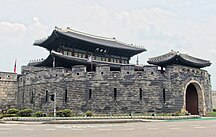
In 936, the Later Three Kingdoms were united by Wang Geon, a descendant of Goguryeo nobility,[75] who established Goryeo as the successor state of Goguryeo.[14][15][76][77] Balhae had fallen to the Khitan Empire in 926, and a decade later the last crown prince of Balhae fled south to Goryeo, where he was warmly welcomed and included in the ruling family by Wang Geon, thus unifying the two successor nations of Goguryeo.[78] Like Silla, Goryeo was a highly cultural state, and invented the metal movable type printing press.[26] After defeating the Khitan Empire, which was the most powerful empire of its time,[79][80] in the Goryeo–Khitan War, Goryeo experienced a golden age that lasted a century, during which the Tripitaka Koreana was completed and significant developments in printing and publishing occurred. This promoted education and the dispersion of knowledge on philosophy, literature, religion, and science. By 1100, there were 12 universities that produced notable scholars.[81][82]
However, the Mongol invasions in the 13th century greatly weakened the kingdom. Goryeo was never conquered by the Mongols, but exhausted after three decades of fighting, the Korean court sent its crown prince to the Yuan capital to swear allegiance to Kublai Khan, who accepted and married one of his daughters to the Korean crown prince.[83] Henceforth, Goryeo continued to rule Korea, though as a tributary ally to the Mongols for the next 86 years. During this period, the two nations became intertwined as all subsequent Korean kings married Mongol princesses,[83] and the last empress of the Yuan dynasty was a Korean princess. In the mid-14th century, Goryeo drove out the Mongols to regain its northern territories, briefly conquered Liaoyang, and defeated invasions by the Red Turbans. However, in 1392, General Yi Seong-gye, who had been ordered to attack China, turned his army around and staged a coup.
Yi Seong-gye declared the new name of Korea as "Joseon" in reference to Gojoseon, and moved the capital to Hanseong (one of the old names of Seoul).[84] The first 200 years of the Joseon dynasty were marked by peace and saw great advancements in science[85][86] and education,[87] as well as the creation of Hangul by Sejong the Great to promote literacy among the common people.[88] The prevailing ideology of the time was Neo-Confucianism, which was epitomized by the seonbi class: nobles who passed up positions of wealth and power to lead lives of study and integrity. Between 1592 and 1598, Japan under Toyotomi Hideyoshi launched invasions of Korea, but the advance was halted by Korean forces (most notably the Joseon Navy led by Admiral Yi Sun-sin and his renowned "turtle ship") with assistance from righteous army militias formed by Korean civilians, and Ming dynasty Chinese troops.[89] Through a series of successful battles of attrition, the Japanese forces were eventually forced to withdraw, and relations between all parties became normalized. However, the Manchus took advantage of Joseon's war-weakened state and invaded in 1627 and 1637 and then went on to conquer the destabilized Ming dynasty. After normalizing relations with the new Qing dynasty, Joseon experienced a nearly 200-year period of peace. Kings Yeongjo and Jeongjo particularly led a new renaissance of the Joseon dynasty during the 18th century.[90][91]
In the 19th century, Joseon began experiencing economic difficulties and widespread uprisings, including the Donghak Peasant Revolution. The royal in-law families had gained control of the government, leading to mass corruption and weakening of the state.[citation needed] In addition, the strict isolationism of the Joseon government that earned it "the hermit kingdom" became increasing ineffective due to increasing encroachment from powers such as Japan, Russia, and the United States. This is exemplified by the Joseon–United States Treaty of 1882, in which it was compelled to open its borders.
Japanese occupation and World War II
In the late 19th century, Japan became a significant regional power after winning the First Sino-Japanese War against Qing China and the Russo-Japanese War against the Russian Empire. In 1897, King Gojong, the last king of Korea, proclaimed Joseon as the Korean Empire. However, Japan compelled Korea to become its protectorate in 1905 and formally annexed it in 1910. What followed was a period of forced assimilation, in which Korean language, culture, and history were suppressed.[92] This led to the March 1st Movement protests in 1919 and the subsequent foundation of resistance groups in exile, primarily in China. Among the resistance groups was Provisional Government of the Republic of Korea.[93]
Towards the end of World War II, the U.S. proposed dividing the Korean peninsula into two occupation zones: a U.S. zone and a Soviet zone. Dean Rusk and Charles H. Bonesteel III suggested the 38th parallel as the dividing line, as it placed Seoul under U.S. control. To the surprise of Rusk and Bonesteel, the Soviets accepted their proposal and agreed to divide Korea.[94]
Modern history

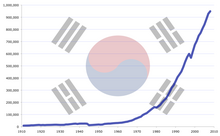
Despite intentions to liberate a unified peninsula in the 1943 Cairo Declaration, escalating tensions between the Soviet Union and the United States led to the division of Korea into two political entities in 1948: North Korea and South Korea.
In the South, the United States appointed and supported the former head of the Korean Provisional Government Syngman Rhee as leader. Rhee won the first presidential elections of the newly declared Republic of Korea in May 1948. In the North, the Soviets backed a former anti-Japanese guerrilla and communist activist, Kim Il-sung, who was appointed premier of the Democratic People's Republic of Korea in September.[96]
In October, the Soviet Union declared Kim Il-sung's government as sovereign over both the north and south. The UN declared Rhee's government as "a lawful government having effective control and jurisdiction over that part of Korea where the UN Temporary Commission on Korea was able to observe and consult" and the government "based on elections which was observed by the Temporary Commission" in addition to a statement that "this is the only such government in Korea."[97] Both leaders engaged in authoritarian repression of political opponents.[98] South Korea requested military support from the United States but was denied,[99] and North Korea's military was heavily reinforced by the Soviet Union.[100][101]
Korean War
On 25 June 1950, North Korea invaded South Korea, sparking the Korean War, the Cold War's first major conflict, which continued until 1953. At the time, the Soviet Union had boycotted the UN, thus forfeiting their veto rights. This allowed the UN to intervene in a civil war when it became apparent that the superior North Korean forces would unify the entire country. The Soviet Union and China backed North Korea, with the later participation of millions of Chinese troops. After an ebb and flow that saw both sides facing defeat with massive losses among Korean civilians in both the north and the south, the war eventually reached a stalemate. During the war, Rhee's party promoted the One-People Principle, an effort to build an obedient citizenry through ethnic homogeneity and authoritarian appeals to nationalism.[102]
The 1953 armistice, never signed by South Korea, split the peninsula along the demilitarized zone near the original demarcation line. No peace treaty was ever signed, resulting in the two countries remaining technically at war. Approximately 3 million people died in the Korean War, with a higher proportional civilian death toll than World War II or the Vietnam War, making it one of the deadliest conflicts of the Cold War era.[103][104] In addition, virtually all of Korea's major cities were destroyed by the war.[105]
Post-Korean War (1960–1990)

In 1960, a student uprising (the "April Revolution") led to the resignation of the autocratic President Syngman Rhee. This was followed by 13 months of political instability as South Korea was led by a weak and ineffectual government. This instability was broken by the 16 May 1961 coup led by General Park Chung Hee. As president, Park oversaw a period of rapid export-led economic growth enforced by political repression. Under Park, South Korea took an active role in the Vietnam War.[106]
Park was heavily criticized as a ruthless military dictator, who in 1972 extended his rule by creating a new constitution, which gave the president sweeping (almost dictatorial) powers and permitted him to run for an unlimited number of six-year terms. The Korean economy developed significantly during Park's tenure. The government developed the nationwide expressway system, the Seoul subway system, and laid the foundation for economic development during his 17-year tenure, which ended with his assassination in 1979.
The years after Park's assassination were marked again by political turmoil, as the previously suppressed opposition leaders all campaigned to run for president in the sudden political void. In 1979, General Chun Doo-hwan led the coup d'état of December Twelfth. Following the coup d'état, Chun planned to rise to power through several measures. On May 17, Chun forced the Cabinet to expand martial law to the whole nation, which had previously not applied to the island of Jejudo. The expanded martial law closed universities, banned political activities, and further curtailed the press. Chun's assumption of the presidency through the events of May 17 triggered nationwide protests demanding democracy; these protests were particularly focused in the city of Gwangju, to which Chun sent special forces to violently suppress the Gwangju Democratization Movement.[107]
Chun subsequently created the National Defense Emergency Policy Committee and took the presidency according to his political plan. Chun and his government held South Korea under a despotic rule until 1987, when a Seoul National University student, Park Jong-chul, was tortured to death.[108] On June 10, the Catholic Priests Association for Justice revealed the incident, igniting the June Democratic Struggle across the country. Eventually, Chun's party, the Democratic Justice Party, and its leader, Roh Tae-woo, announced the June 29 Declaration, which included the direct election of the president. Roh went on to win the election by a narrow margin against the two main opposition leaders, Kim Dae-jung and Kim Young-sam. Seoul hosted the Olympic Games in 1988, widely regarded as successful and a significant boost for South Korea's global image and economy.[109]
South Korea was formally invited to become a member of the United Nations in 1991. The transition of Korea from autocracy to modern democracy was marked in 1997 by the election of Kim Dae-jung, who was sworn in as the eighth president of South Korea on 25 February 1998. His election was significant given that he had in earlier years been a political prisoner sentenced to death (later commuted to exile). He won against the backdrop of the 1997 Asian financial crisis, where he took IMF advice to restructure the economy and the nation soon recovered its economic growth, albeit at a slower pace.[110]
Contemporary history

In June 2000, as part of President Kim Dae-jung's "Sunshine Policy" of engagement, a North–South summit took place in Pyongyang, the capital of North Korea.[111] Later that year, Kim received the Nobel Peace Prize "for his work for democracy and human rights in South Korea and in East Asia in general, and for peace and reconciliation with North Korea in particular".[112] However, because of discontent among the population for fruitless approaches to the North under the previous administrations and, amid North Korean provocations, a conservative government was elected in 2007 led by President Lee Myung-bak, former mayor of Seoul.[113] Meanwhile, South Korea and Japan jointly co-hosted the 2002 FIFA World Cup.[114] However, South Korean and Japanese relations later soured because of conflicting claims of sovereignty over the Liancourt Rocks.[115]

In 2010, there was an escalation in attacks by North Korea. In March 2010 the South Korean warship ROKS Cheonan was sunk killing 46 South Korean sailors, allegedly by a North Korean submarine. In November 2010 Yeonpyeong Island was attacked by a significant North Korean artillery barrage, with 4 people dying. The lack of a strong response to these attacks from both South Korea and the international community (the official UN report declined to explicitly name North Korea as the perpetrator for the Cheonan sinking) caused significant anger with the South Korean public.[117]
South Korea saw another milestone in 2012 with the first ever female President Park Geun-hye elected and assuming office. The daughter of former President Park Chung Hee, she carried on a conservative brand of politics.[118] President Park Geun-hye's administration was formally accused of corruption, bribery, and influence-peddling for the involvement of close friend Choi Soon-sil in state affairs. There followed a series of massive public demonstrations from November 2016,[119] and she was removed from office.[120] After the fallout of Park's impeachment and dismissal, elections were held and Moon Jae-in of the Democratic Party won the presidency, assuming office on 10 May 2017.[121] His tenure saw an improving political relationship with North Korea, some increasing divergence in the military alliance with the United States, and the successful hosting of the Winter Olympics in Pyeongchang.[122] In April 2018, Park Geun-hye was sentenced to 24 years in jail because of abuse of power and corruption.[123] The COVID-19 pandemic has affected the nation since 2020. That same year, South Korea recorded more deaths than births, resulting in a population decline for the first time on record.[124]
In March 2022, Yoon Suk Yeol, the candidate of conservative opposition People Power Party, won a close election over the Democratic Party candidate by the narrowest margin ever. Yoon was sworn in on 10 May 2022.[125]
Geography
Geography

South Korea occupies the southern portion of the Korean Peninsula, which extends some 1,100 km (680 mi) from the Continental and East Asian mainland. This mountainous peninsula is flanked by the Yellow Sea to the west and the Sea of Japan to the east. Its southern tip lies on the Korea Strait and the East China Sea. The country, including all its islands, lies between latitudes 33° and 39°N, and longitudes 124° and 130°E. Its total area is 100,410 square kilometers (38,768.52 sq mi)[6]
South Korea can be divided into four general regions: an eastern region of high mountain ranges and narrow coastal plains; a western region of broad coastal plains, river basins, and rolling hills; a southwestern region of mountains and valleys; and a southeastern region dominated by the broad basin of the Nakdong River.[126] South Korea is home to three terrestrial ecoregions: Central Korean deciduous forests, Manchurian mixed forests, and Southern Korea evergreen forests.[127] South Korea's terrain is mostly mountainous, most of which is not arable. Lowlands, located primarily in the west and southeast, make up only 30% of the total land area. South Korea has 20 national parks and popular nature places like the Boseong Tea Fields, Suncheon Bay Ecological Park, and Jirisan.[128]
About 3,000 islands, mostly small and uninhabited, lie off the western and southern coasts of South Korea. Jeju Province is about 100 kilometers (62 miles) off the southern coast of South Korea. It is the country's largest island, with an area of 1,845 square kilometers (712 square miles). Jeju is also the site of South Korea's highest point: Hallasan, an extinct volcano, reaches 1,950 meters (6,400 feet) above sea level. The easternmost islands of South Korea include Ulleungdo and Liancourt Rocks (Dokdo/Takeshima), while Marado and Socotra Rock are the southernmost islands of South Korea.[126]
Climate
| Seoul | ||||||||||||||||||||||||||||||||||||||||||||||||||||||||||||
|---|---|---|---|---|---|---|---|---|---|---|---|---|---|---|---|---|---|---|---|---|---|---|---|---|---|---|---|---|---|---|---|---|---|---|---|---|---|---|---|---|---|---|---|---|---|---|---|---|---|---|---|---|---|---|---|---|---|---|---|---|
| Climate chart (explanation) | ||||||||||||||||||||||||||||||||||||||||||||||||||||||||||||
| ||||||||||||||||||||||||||||||||||||||||||||||||||||||||||||





